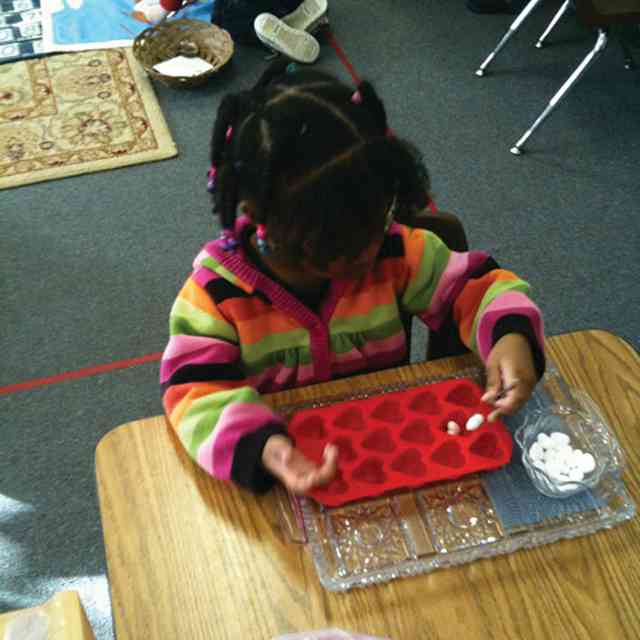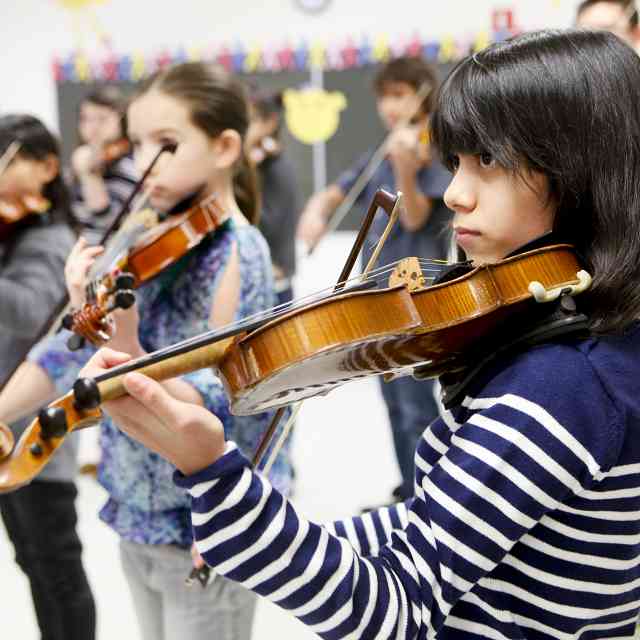Since 2000, I’ve enjoyed a long relationship with the method created by Shin’ichi Suzuki (1898–1998). First as a collaborative pianist, working with students and faculty at the Wyoming String Academy in Cincinnati, Ohio, then at the same institution creating Dalcroze-inspired music and movement courses for their music theory program. Years later, the youth curriculum began at the Dalcroze School of Music and Movement (formerly the Dalcroze School of the Rockies). From the beginning, I had several students who were doing both Dalcroze Education and the Suzuki Method. I was thrilled that our graduates had developed a deep love and understanding of music; some even went on to study music at prestigious institutions. Around this time, I began working with Suzuki institute directors around the country to bring Dalcroze Education to Suzuki summer programs and to the Suzuki community at large. I am indebted to the intrepid vision of individuals such as Ann Kitayama, Gail Seay, Bruce Boiney, Kathie Reed, Cynthia Scott, Donna Davis, Gail Johansen, Ramona Stirling, Pam Brasch, and April Losey, who believed that Dalcroze Eurhythmics would provide students a unique and valuable education in addition to their Suzuki background. This opened other opportunities to place Suzuki and Dalcroze pedagogy in dialogue with one another at conferences and festivals.
Today, the relationship between Suzuki and Dalcroze is developing further at the Suzuki Music Institute of Dallas (SMID), where the Dalcroze School of Music and Movement (DSM) curriculum is integrated into SMID’s musicianship program for students of all ages and levels. It has been a rich journey that has shown me how Dalcroze and Suzuki complement each other in a rather elegant way. This doesn’t mean that there haven’t been hiccups and difficulties, as would happen with any program transition. We are in our second year, and I am grateful to SMID faculty including Dr. Rhea Edelman, Executive Director and Department Head of Strings and Dr. Bret Serrin, Department Head of Keyboard and Harp, for their continued effort to bring these two methods together. We hope that sharing our experiences might be useful for readers.
Historical Perspectives
Émile Jaques-Dalcroze (1865–1950) was a student of Léo Delibes, Gabriel Fauré, and Anton Bruckner. He was the first to develop a modern method of music education that involved students moving their whole bodies away from their instruments to become better musicians. He first began as a professor at the Conservatoire de Genève in Switzerland, teaching professional adult students. He understood that learning repertoire alone was not always successful in creating sensitive musicians who had suppleness and steadiness in pulse, rhythm, and meter. Further, he felt that the traditional means of teaching solfège did not always develop the “inner ear” of students, and they didn’t readily understand the “feeling” of pitches. The push/pull of certain tendency tones within a scale was not clear to them, and they did not have a clear understanding of melodic function or pitch names.
To begin, Dalcroze had students work on musical skills through simple movements: walking, running, skipping, lunging, etc. He proposed that movement was essential to deepen musical knowledge, stimulate creativity and imagination, promote suppleness in mind and body, and nurture the student’s ownership of the material. He had students move in bare feet to improvised music while changing elements such as tempo, dynamics, rhythm, meter, and tonality. Students were challenged to listen with a type of attentiveness that was revolutionary because they were asked to demonstrate these changes in the music. Then (and now!), change was the only constant in the Dalcroze hall, and this proved to be a very successful pedagogy. Thus, by the early 1900s, la Méthode Jaques-Dalcroze was born. Later, he had much success adapting his method for children; he took troupes of his young students around Europe to great acclaim. All the while, he composed volumes of symphonic literature, chamber music, piano music, vocal music, operas, and theater pieces, in addition to writing many books and articles on his method. His work inspired future dancers including Isadora Duncan, Sergei Diaghilev (and the Ballet Russes), Marie Rambert, and Mary Wigman, along with musicians such as Ernest Bloch, Arthur Honegger, Jaqueline Du Pré, and many others.
To this day, Dalcroze students of all ages study eurhythmics (rhythm, meter, phrasing, form, and nuance), solfège (the training of eyes and ears in melody and harmony), improvisation (combining the elements of eurhythmics and solfège in creative and expressive ways), and plastique animée (a visual analysis of a piece of music using the body).
Similar Philosophies
There are many similarities between Dalcroze and Suzuki, more than I could list within the scope of this article. I’ll focus on just a few that have played a large part in my work thus far, concentrating on the Dalcrozian elements, since readers are probably more familiar with Suzuki’s pedagogy.
Suzuki and Dalcroze share a similar focus in developing the musical “mother tongue” so that the ear guides the student to understand music. To this end, Dalcroze created volumes of song material for the Swiss people to sing, particularly with/for children. He wrote hundreds of Rondes, Pieces Enfantines, Chansons Populaire, and Marches Rythmiques expressly to encourage the Swiss citizens to sing beautiful music while developing musical sensitivity, expression, and literacy. These pieces are still sung by the Swiss today, and he has left an indelible mark on that culture through his contributions to their musical community.
Another substantial similarity between the two methods is their desire to create a society of people who are musically sensitive, which would undoubtedly influence other aspects of their daily life. Phrases synonymous with Suzuki such as “Beautiful tone, beautiful heart” and “Character first, ability second” are matched by Dalcroze on page 5 of his preface to Rhythmic Movement, Vol. 1:
The aim of my teaching is to make my pupils able to say at the end of their studies, not “I know” but “I feel,” and also to create in them the desire to express themselves; for when an emotion is strongly felt there is an immediate desire to communicate it to others to the best of one’s ability. The more life we possess the more we shall be able to spread life around us. To receive, to give, that is the great law of humanity.
He elaborates further on page 130 of Rhythm Music and Education: “The most important element in music lessons should be their general effect of awakening in the pupil a love for the art; for that purpose, it is necessary—passing from the general to the particular—to initiate him into the two primordial elements of music: rhythm and tone.”
Dalcroze and Suzuki also align on their importance of the student-teacher relationship. Parental relationships were important to Dalcroze and he wrote often about them. In Eurhythmics Art and Education (p. 101), he alludes to the collaboration between teacher and parent: “the function of parents and teachers is to strengthen and develop the child in such fashion that mind and body form a perfect instrument whereon to learn to play the song of life." Like Suzuki, Dalcroze was constantly looking deeper than mere virtuosity and note-perfect performances. The instructor (and the parent) bears a lot of responsibility in developing the student as a whole being. He states it clearly in Rhythm Music and Education: “A true pedagogue should be at once psychologist, physiologist, and artist. The complete citizen should leave school capable not only of living normally, but of feeling life. He should be in a position both to create and to respond to the creations of others.”
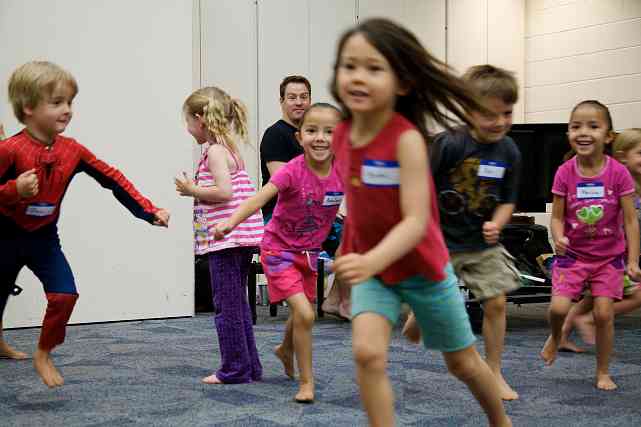
Listening with the whole body. Jeremy Dittus at the piano leading the students in reaction exercises to stimulate creativity and imagination.
Unique Aspects of La Méthode Jaques-Dalcroze
Now that we’ve pointed out some similarities, it’s worthwhile to address some unique features of Dalcroze Education that make it useful to Suzuki teachers. Indeed, Suzuki teachers might already incorporate some of these ideas, but it’s interesting to consider the Dalcrozian perspective.
Throughout his method, Dalcroze believed that students should experience music first before they analyze it, that they should move to the music with their whole bodies first before any terms are discussed, and that development of the body as musical instrument was tantamount to all other forms of learning. Dalcroze states his beliefs best on page 5 of his preface to Rhythmic Movement, Vol. 1: “The whole method is based on the principle that theory must follow practice, that rules must not be taught to children until they have themselves experienced the facts that gave rise to the rules, and that the first thing one must teach them is to know themselves. The opinions and conclusions of others should not be taught to them until later.” It is a tall order, for sure—one that takes time to develop and cannot be rushed.
Dalcroze felt very strongly that music itself should be the teacher in as many ways as possible; to this day, many Dalcrozians describe the work as “an education in and through music.” Suzuki shared this sentiment, as he once told a reporter that his method “is not education of the violin, it is education by the violin.” However, unlike Suzuki, who developed a systematic series of repertoire to teach the fundamental technique of each instrument, Dalcroze was rather opposed to having students learn music in any one given fashion, system, or approach. Rather, it is up to the teacher to decide what, when, and how music should be taught. Regardless, it is primarily the music that guides the ears, eyes, bodies, and hearts of the students through the class. As Dalcroze put it on page 2 of La Grammaire de la Rythmique: “The method I have created, that bears my name, aims to harmonize one’s spiritual and bodily capabilities through music. Our system of education uses music to play the triple role of stimulator, motivator, and regulator.”
It is worth stating that Dalcroze didn’t have to worry about the technical level of performance with his students: they were all performing at a very high level before they arrived at the Conservatoire de Genève. Similarly, Suzuki didn’t necessarily have to focus on musicianship courses (e.g., music theory, solfège, rhythm, literacy, etc.) in his students’ lessons because this was addressed in their solfège classes in the schools. Both pedagogues took advantage of the fact that a significant part of musical development took place outside their respective methods. Consequently, like the Yin and Yang, Dalcroze and Suzuki can mold to one another exquisitely. As the two methods have developed in the last century and into the present day, it is no wonder that many of us have come to realize the benefits of weaving these two pedagogies together.
Harmony in Diverse Approaches
With these unique principles in mind, Dalcrozians have brought their love of music through movement to Suzuki students over the last century. Through their passion for musical excellence and incredible teamwork, the Suzuki community has created a fabulous platform for students to learn to play their instruments at a very high level, arguably more than any other method on the planet has been able to do. Naturally, this takes time to accomplish each week—usually more time than can easily fit within individual lessons. This is where I feel Dalcroze Education fits into the picture so beautifully: we tackle the concepts Suzuki teachers may not have time to address each week. Of course, this is not to imply that Suzuki teachers don’t teach musicianship. This couldn’t be further from the truth, and there are many ways in which Suzuki teachers are actively addressing these skills in group classes and private lessons. Nevertheless, Dalcroze Education does bring important features to Suzuki pedagogy, and by working together, we can create a fantastic stage on which our students can grow.
In every class, Dalcrozians strive to cultivate their students’ musicianship skills from the inside-out. Dalcroze pedagogy creates an environment for students to discover and experience how music sounds, how it feels, how it moves, and finally how it appears in a score. We offer multiple ways of knowing, so that diverse learners can find an avenue to develop their own musical understanding. We challenge students to think creatively and imaginatively about their musicianship training, to improvise with their voice and their bodies, and to embrace different ways of knowing music beyond playing their instrument. Through embodiment, students develop a unique musical ownership that encourages freedom and suppleness when they approach their instrumental repertoire. In this way, Dalcroze and Suzuki enjoy a type of symbiosis that I find both elegant and inspiring.
Structures
At the Suzuki Music Institute of Dallas (SMID), students enrolled in the full program have a weekly private lesson, instrument-specific Suzuki group class, and Dalcroze group class for students who are ages four and up. The DSM curriculum for youth has three primary programs: Eurhythmics courses for students ages four to seven; Rhythmic-Solfège (RS) for students ages six to fourteen, and Advanced Dalcroze (AD) for students ages eleven to eighteen. (Please see the DSM website for more specifics.) We group the students as much as possible by age and Dalcroze level, which is essential since five-year-old children move very differently than those who are twelve. We try to make every student’s Suzuki group class or private lesson on the same day as their Dalcroze class to reduce the driving burden on parents.
In terms of assignments, Suzuki students have their standard scales, etudes, and repertoire that largely depends on the individual faculty member. Suzuki group classes typically last between thirty and sixty minutes each week. In Dalcroze, Eurhythmics students attend class without parents for forty-five minutes. They have a “funsheet” that they take home and complete each week that reinforces what we have learned in class. Rhythmic-Solfège and Advanced Dalcroze students have class for sixty minutes each week plus weekly assignments to work on at home using their metallophone. Assignments include melodies and rhythms to sing, play, or conduct, and written work in the form of puzzles, games, and more to build their music theory knowledge and relate it to their overall musicianship. We use both pitch and function systems to teach solfège: letter names for note names and scale degree numbers for pitch function. We use a variety of Rhythmic-Solfège languages (movement words, rhythm colors, etc.) to help students internalize rhythm and meter deeply. Having a variety of systems for rhythm and pitch helps students embrace the idea that there are multiple ways of knowing music.
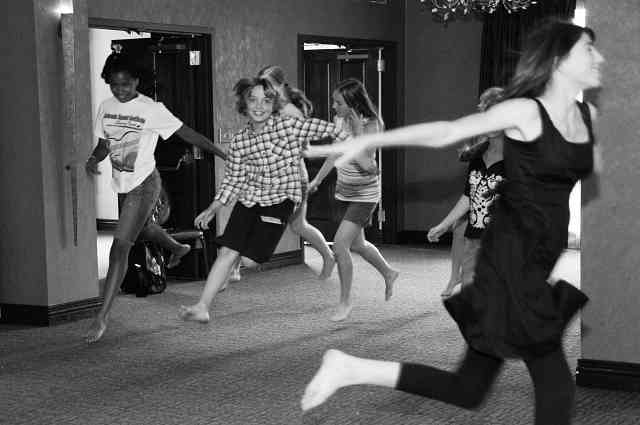
Teenage students participating in a Dalcroze class at the Colorado Suzuki Institute.
At the end of each academic year, Rhythmic-Solfège and Advanced Dalcroze students have Exit Evaluations where they move, sing, and conduct both melodies and rhythms for a jury to pass onto the next Dalcroze level, much the same way that students must pass their Suzuki Book recitals to move on to the next book. As the students move through higher levels, we add dictation, improvisation, and other elements to their evaluations. Additionally, SMID has an Achievement Week each winter where students perform scales, etudes, repertoire, and a Dalcroze component for the entire faculty. All of this promotes high standards and the integration of the two methods in one institution.
Faculty members are able to collaborate and address the needs of students who might be struggling with certain musical concepts. We have had some wonderful success stories. Teachers might share that a particular student is having trouble with a given rhythmic pattern or hearing the difference between whole steps and half steps, and I can take time in class to address those concerns. The SMID faculty has been very open to using new rhythmic vocabulary in their lessons that the students use in class with me. This helps to create solidarity as a faculty. Of course, teachers are not required to use the vocabulary or systems that the students use in class, which is good for the students, too: diversity in approach only helps students to grow.
Like the Suzuki Method, Dalcroze Education takes time. Imparting the virtues of patience and diligence is challenging for all teachers, and this is no exception. I often say that this type of learning is a marathon, not a sprint; progress will often be nonlinear. Students don’t always recognize how movement and music really impact their development. This is mostly because experiential and discovery-based learning is not instantaneous—yet we live in a world of instant gratification. Further, some students are not used to the freedom of expression and movement that Dalcroze offers, and this can be unsettling at first. One of my strategies is to offer students at least one way they could move to a given concept, but then encourage them to find their own ways, too. In time, our students will develop their movement vocabulary and grow more comfortable expressing their own ideas. This is already happening in small ways with many of our students, and it is exciting to see it unfold! We have observed substantial musical growth from the 2022 Achievement Week performances to the 2023 Achievement Week performances. I can’t help but think that the addition of Dalcroze into the musical fabric of these students’ lives has played at least a small part their development and improvement. To that end, it would be useful to hear from two SMID departmental faculty chairs about their experiences.
Strings Perspectives
By Rhea Edelman
One of the great strengths of the Suzuki method is that it allows young children to play real and interesting music beautifully from early on in their training. However, the challenge is to first teach music far beyond their intellectual understanding, and then to develop both the understanding and intuition to match their skills. As teachers, we all struggle with how to balance teaching technique, repertoire, theory, fingerboard geography, and musicality, all within a weekly lesson.
SMID students have always had a separate theory class, and this has been a huge support to our private and group lessons. However, even students with a theory program often struggle with how to apply their acquired knowledge in context on their instruments. Because of the experiential nature of learning, Dalcroze seems to bridge this gap and gives students both the intellectual understanding and true ownership of the concepts. Only in our second year, I have seen several important developments in my students resulting from their Dalcroze classes. An important skill that I had previously left off my long teacher “to do” list is the incorporation of signing.
The ability to sing opens a world of possibilities for students. A difficult passage can be simplified by taking out the logistics of the violin and developing first a true understanding of what must be performed. If a student is struggling with something and I have them first sing it, they can then, almost invariably, play it better. Singing with solfège also allows students the freedom to create the shape of the phrase they want in their minds first, and then create the sound on their instrument. Think how many times in our own professional practice we might sing something through in our head before playing it. The pitches can then be anticipated instead of searched for, and the rhythm can be felt instead of forced. However, it is difficult if not impossible for students to learn to sing in their heads if they are not first able to learn to sing aloud. Even students with great ears don’t always know how to use their voice, and it is immensely helpful for them to develop this ability as they learn solfège, scale degrees, intervals and more.
I am also finding students more rhythmically aware. They have taken to the Dalcroze Rhythmic-Solfège systems and use them in their playing. Because they are used to singing and moving the rhythms, their ease and steadiness in playing them is a natural extension. This seems to be helping in reading development as well, since the rhythms in the early reading levels and the Dalcroze rhythm learning are closely aligned.
As our young beginners grow over the next couple of years, I will be most interested to see how their musical expression and intuition develops as well. Students used to singing, conducting, and moving their bodies to music will likely develop more natural movement and physical expression in their own playing. In their Dalcroze courses, students react to what they hear and learn to anticipate what will come. For example, they might hear an antecedent phrase and then improvise their own consequent phrase that balances the period structure. I am excited to see how this development of musical intuition away from their instrument will combine with our emphasis of musical playing in the studio as these young students grow.
As a parent of a four-year-old pianist who started Dalcroze at the same time as lessons, I have noticed similar developments in his learning. Although we have not started note reading in piano lessons, he is eager and able to identify simple rhythm patterns by sight and ear in his music, and we incorporate singing the rhythm colors to keep steady pulse and correct rhythms. I’ve seen him develop his vocal skills which allows him to sing his pieces in tune; after all, just because a child can hear doesn’t mean they can vocalize accurately. He has fun creating/improvising lyrics and I often catch him humming his pieces during the day. But most importantly for this stage, he loves to move expressively to music. He is learning to feel the music and really listen and react to rhythms, dynamics, character and shaping. We are creating true interest in playing with expression from a young age, backed up with the technical excellence to allow musicality and the development of intellectual understanding to support the intuition.
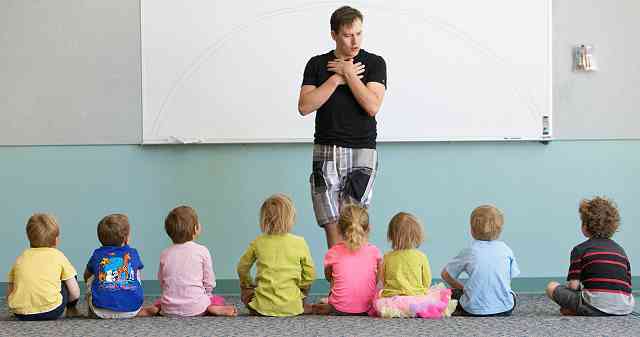
Jeremy Dittus teaching phrasing to a group of young musicians ages 4–7 in Colorado.
Keyboard/Harp Perspectives
By Bret Serrin
The addition of the Dalcroze component to the music curriculum at SMID has been revolutionary. It has helped us to achieve a more comprehensive and integrated approach in how we aspire to create the most thoughtful and intuitive musicians. All of us as Suzuki teachers understand the vital necessity and importance of music theory, as it informs both our approach and our intellectual understanding of the repertoire we teach. As a pianist, one certainly cannot teach the significant compositions of Bach, Mozart, Beethoven, Chopin, Liszt, and Rachmaninoff without the greatest understanding of harmonies, rhythmic relationships, counterpoint, meter, and a host of other elements. A cerebral understanding imparts a greater depth of feeling to a student’s performance, simply by the nature of better perception. However, I have always sought for the best way to apply these concepts to a child’s pianism.
What Dalcroze does so successfully, and what I have seen in abundance in my students’ growth over the last couple of years, is a true melding of a child’s intellect and intuition. As a teacher, I have always been most interested in the application—how they listen, how they perceive tone, how they learn and intuit a phrase, and how they internalize and “feel” music. My youngest pianists are learning how to move in time and embody what they are playing, which is much more applicable to a successful performance than simply understanding the nature of a time signature from a numerical perspective.
The element of singing and solfège training, while certainly not unique to Dalcroze, is an enormous part of their training. Our voice is the one instrument we all possess and is the most natural part of learning how to shape a phrase at all levels of development. Learning to sing in the most expressive way on scale degrees, letter numbers, and Rhythmic-Solfège has a fantastic application from both a theoretical and a musical perspective. My advanced students are learning to move and execute polyrhythms, which are so important in the performance of advanced piano repertoire. They are also learning to sing in harmony with each other, which includes the understanding of how and why harmonies dictate their phrasing. These are just a few small examples of how the Dalcroze curriculum has impacted this department at SMID.
Codetta
I look forward to the coming years to see how the Dalcroze program at SMID grows and how the dialogue between the two methods develops. We are still in the beginning stages of our time together, and already I can tell we are making a difference . . . and that’s really thrilling!
References
Jaques-Dalcroze, Émile. Eurhythmics, Art, and Education. Trans. Fredrick Rothewell. Ed. Cynthia Cox. London: Chatto and Windus, 1930.
Jaques-Dalcroze, Émile. Rhythm, Music, and Education. Trans. Harold Rubenstein. London: The Dalcroze Society, 1921.
Jaques-Dalcroze, Émile. “La Grammaire de la Rythmique,” Le Rythme N° 17, trans. Jeremy Dittus. Genève, Institut Jaques-Dalcroze, 1926
Jaques-Dalcroze, Émile. Rhythmic Movement Volume I. London: Novello and Company, 1920.




